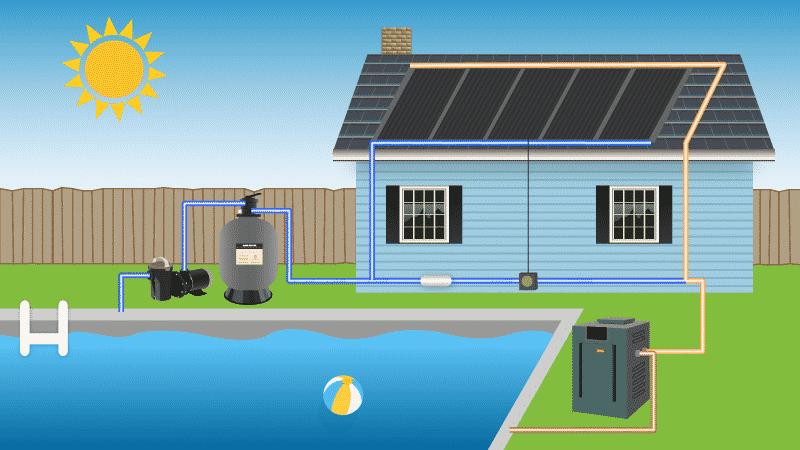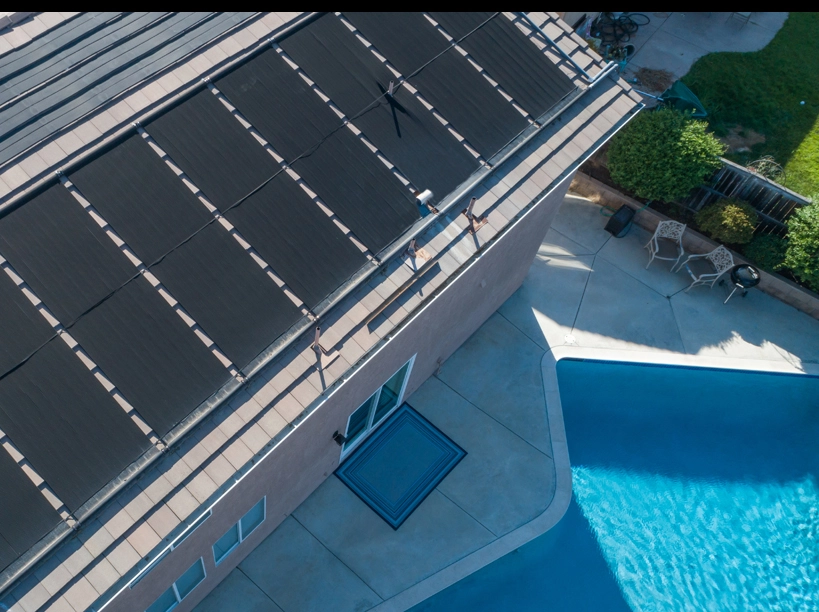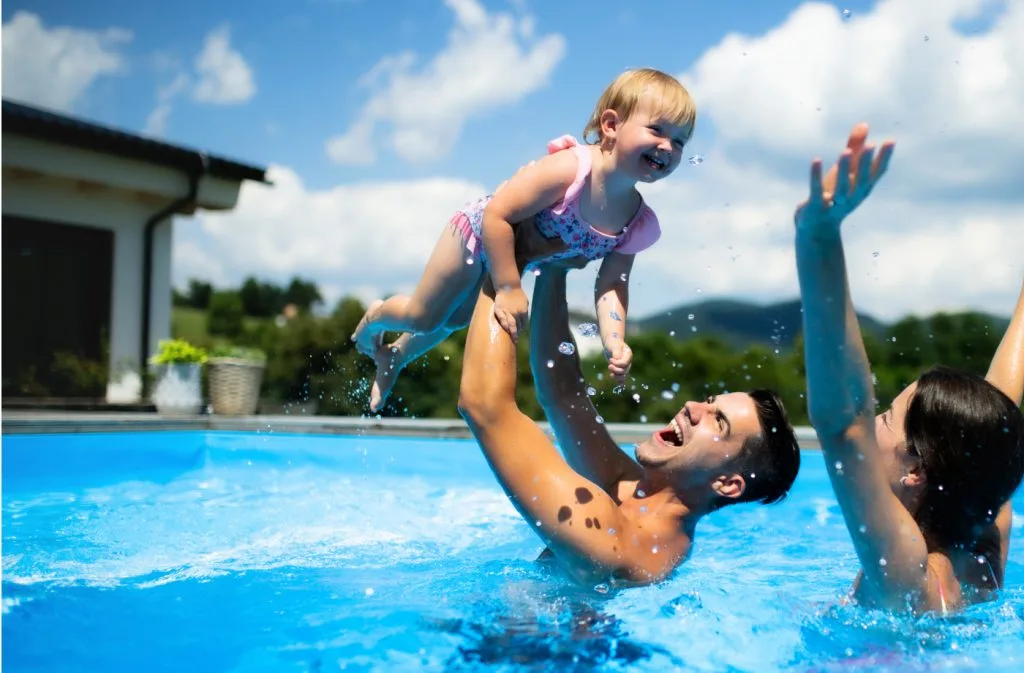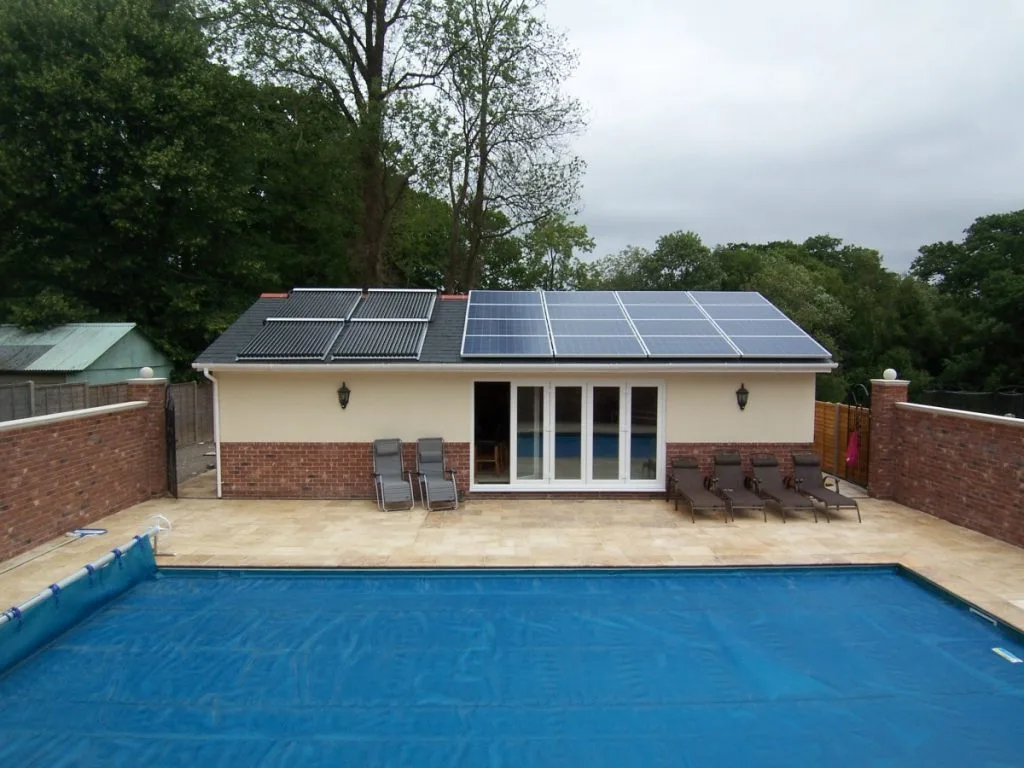Pool heating costs can be significantly reduced by installing a solar pool heater. They are cost-competitive with both gas and heat pump pool heaters and have very low annual operating costs. In fact, in some climates, solar pool heating is one of the most cost-effective ways to utilize solar energy.
How Solar Pool Heaters Work?
Most solar pool heating systems include the following:
Solar collector – the device that circulates the pool water and is heated by the sun Illustration of a solar panel. Each end of the panel has a tube and arrows show the flow through one tube, across the panel, and out the end of another tube (labeled collector/manifold).
Filter – removes debris before water is pumped into the collector
Pump – circulates water through the filter and collector and back to the basin
Flow control valve – an automatic or manual device that transfers pool water to the solar collector.
Pool water is pumped through the filter and then through the solar collector where it is heated before being returned to the pool. In hot climates, the collector can also cool the pool by circulating water through the collector at night during peak summer months.

Some systems include sensors and automatic or manual valves to divert water through the collector when the collector temperature is sufficiently higher than the pool temperature. When the collector temperature is similar to the pool temperature, the filtered water simply bypasses the collector and returns to the pool.
Solar pool collectors are made of different materials. The type you need depends on your climate and how you intend to use the collector. If you only use your pool when the temperature is above freezing, then you may only need an unglazed collector system.
Unglazed collectors do not include glass covers (glazing). They are usually made of heavy-duty rubber or plastic and treated with ultraviolet (UV) light inhibitors to extend the life of the panels. Unglazed collectors are usually less expensive than glazed collectors due to their inexpensive parts and simple design. These unglazed systems can even be used for indoor pools in cold climates if the system is designed to drain back into the pool when not in use. Even if you have to shut down the system during cold weather, unglazed collectors may be more cost-effective than installing a more expensive glazed collector system.
Choosing a Solar Pool Heater
Purchasing and installing a solar pool heating system typically costs between $2,500 and $4,000. This provides a payback period of 1 to 7 years, depending on your local fuel costs and available solar resources. They also typically last longer than gas and heat pump pool heaters. Your actual costs and returns depend on many factors. Therefore, here are a few things you should do before purchasing and installing a solar pool heating system:
- Assess your site’s solar energy resources
- Determine the correct system size
- Determine the correct orientation and tilt of the collector
- Determine the efficiency of the system
- Compare system costs
- Investigate local codes, covenants, and regulations

Evaluating Your Site’s Solar Energy Resources
Before purchasing and installing a solar pool heating system, you first need to consider your site’s solar resources. The efficiency and design of a solar pool heater depend on how much solar energy reaches your building site.
Solar pool heating systems use both direct and diffuse solar radiation. So even if you live in a climate that isn’t warm and sunny most of the time (such as the southwestern United States), your site may still have ample solar energy resources. Solar pool heaters are especially useful in sunny areas like Phoenix. The abundance of sunny days ensures that the solar collectors get plenty of sunlight for efficient heating and a longer swimming season.
Basically, if your building site has unshaded areas and typically faces south, it’s a good candidate for a solar pool heating system. Your local solar system provider or installer can perform a solar site analysis.
Sizing a Solar Swimming Pool Heater
There are many factors involved in sizing a solar pool heating system:
- Size of the pool
- Length of the swimming season
- Average temperature of the area
- The desired pool temperature
- Site solar energy resources
- Collector orientation and tilt
- Collector efficiency
- Use of pool cover.
Solar system contractors use worksheets and computer programs to help determine system requirements and collector sizing.

Basically, the surface area of the solar collector should equal 50-100% of the surface area of the pool. In cooler and cloudy areas, you may need to increase the ratio between the collector area and pool surface area. Increasing the collector area will also extend the swimming season.
In any climate, you can usually reduce the required collector area by using a pool cover.
You will also need a properly sized pool pump for the solar system. If you are replacing a conventional pool heating system with a solar system, you may need a larger pump than your current pump or a separate smaller pump to transfer the pool water to and through the collector.
Siting a Solar Pool Heater Collector
The collector can be mounted on the roof or anywhere near the pool to provide proper exposure, orientation, and tilt toward the sun. The orientation and tilt of the collector can affect the performance of your solar pool heating system. Your contractor should consider them when evaluating your site’s solar resources and sizing your system.
Collector orientation
Illustration showing collector orientation. Ideally, collectors are oriented due south but can be oriented up to 15 degrees east or west of south.
Solar pool heater collectors should be positioned geographically to maximize daily and seasonal solar energy receipts. In general, the best orientation for solar collectors in the Northern Hemisphere is due south. However, recent studies have shown that depending on your location and collector tilt, your collector can face due south to the east or 45° to the west without significantly reducing its performance.
You also need to consider factors such as roof orientation (if you plan to install the collector on a roof), local landscape features that shade the collector on a daily or seasonal basis, and local weather conditions (foggy mornings or cloudy afternoons), as these may affect the optimal orientation of the collector.
Collector inclination
The illustration shows the ideal collector angle for latitudes of plus or minus 15 degrees, depending on the length of the swimming season.
The angle at which the collector should be tilted varies depending on latitude and the length of the swimming season (summer or year-round). Ideally, the angle of inclination of a collector used for summer heating only should be equal to minus 10°-15° of latitude. Collectors for year-round heating should have a tilt angle equal to your latitude.
However, studies have shown that not tilting the collector at the optimum angle does not significantly reduce system performance. Therefore, you can usually place the collector flat on the roof, which may not be the optimum angle, but is more aesthetically pleasing. However, you will need to consider the roof angle when sizing your system.

Determining the efficiency of a solar pool heating system
You can determine the efficiency of your solar pool heating system based on the thermal performance rating of the collectors, if any.
The thermal performance rating of a solar collector is measured in Btu (British thermal units) per square foot per day: Btu/(ft 2 day)
Alternatively, the rating can be measured in kilowatt-hours (kWh) per square metre per day: kWh/(m2day).
It can also be measured in Btu per day, which is simply the rating in Btu/(ft 2 day) multiplied by the area in ft 2. It is also measured using kWh per day, which is just the rating in kWh/(m2 day) multiplied by the area in m2.
The higher the number, the more efficient the solar collection. However, since weather conditions, instrument accuracy, and other test condition limitations may vary, the thermal performance of any two collectors should be considered approximately the same if their ratings are within 25 Btu/(ft 2 days) of each other.
Not only will high-efficiency solar collectors reduce your annual operating costs, but they may also require less square footage of collector area to heat your pool.
Comparing the cost of solar pool heating systems
Before purchasing a solar pool heating system, you can estimate and compare the cost of using different solar collector models. This will help you determine the potential cost savings of investing in a more efficient type of collector, which may require fewer panels to heat the required area of the pool’s collector.
To estimate and compare costs, you need to know the following information:
- The thermal performance rating of the collector (Btu/day)
- Total number of collector panels or pipes to heat the area needed for the pool
- The total installed cost of the system.
You can then use the following formula to calculate the energy output per dollar spent or invested in the collectors:
(Btu/day X number of collector panels/pipe modules) ÷ Total installed cost of the system = Btu/per dollar spent
If you only know the price and thermal performance rating (Btu/day) of the collector, you can use the following formula to calculate the energy output per dollar spent or invested in different collectors:
Btu/day ÷ collector price = Btu/day per dollar spent
Don’t choose a solar pool heating system or collector based on estimated cost alone. It’s also important to consider all the factors involved in system sizing as well as design and installation quality when choosing a solar pool heater.
Installation and maintenance
The proper installation of a solar pool heating system depends on many factors. These factors include solar energy resources, climate, local building code requirements, and safety issues. Therefore, it is best to have your system installed by a qualified solar thermal system contractor.
After installation, proper maintenance of your system will keep it running smoothly for 10-20 years. Consult your contractor and read your owner’s manual for maintenance requirements. If the pool’s chemical balance and filtration system are checked regularly, your collector should require little maintenance. In dry climates where rainwater does not naturally wash away, the glass collector may need to be cleaned.
Solar pool heaters vs. solar pv panels

Uses – Solar pool heaters are designed to heat pools, while solar photovoltaic panels can be used for a variety of purposes.
Efficiency in Heating Pools – Solar pool heaters are generally more efficient and cost-effective because they use solar heat directly.
Versatility- Solar PV panels offer greater versatility because they can power a variety of electrical devices. It is sometimes more efficient to pair an electric pool heater with a photovoltaic panel to heat your pool.
Conclusion
Solar pool heaters are a smart investment for pool owners looking for an environmentally friendly and cost-effective way to extend the swimming season. By utilizing solar technology, these systems not only reduce energy costs but also help to create a more sustainable environment. With proper setup and maintenance, homeowners can enjoy a warm and inviting pool experience year-round.
FAQ about Solar Pool Heater
| Can a solar pool heater work in all climates?
Solar pool heaters are most effective in sunny climates. However, they can still be used in cooler or cloudier regions with varying degrees of efficiency. In less sunny areas, a larger collector area may be needed. How much does a solar pool heater cost? The cost of a solar pool heater varies based on factors like the size of the pool, the type of system, and installation fees. On average, a system can cost between $3,000 and $7,000. How long do solar pool heaters last? Solar pool heaters can last 10-20 years or more with proper maintenance. Regular inspections and maintenance are essential to ensure longevity. What maintenance is required for a solar pool heater? Maintenance typically involves regular inspections to check for leaks, debris, and proper system operation. Cleaning the solar collectors to ensure maximum efficiency is also important. Can I use my existing pool pump with a solar heater? In most cases, yes. A solar pool heater can be integrated with your existing pool pump and filtration system. However, the pump may need to run longer to circulate the water through the solar collectors. |











